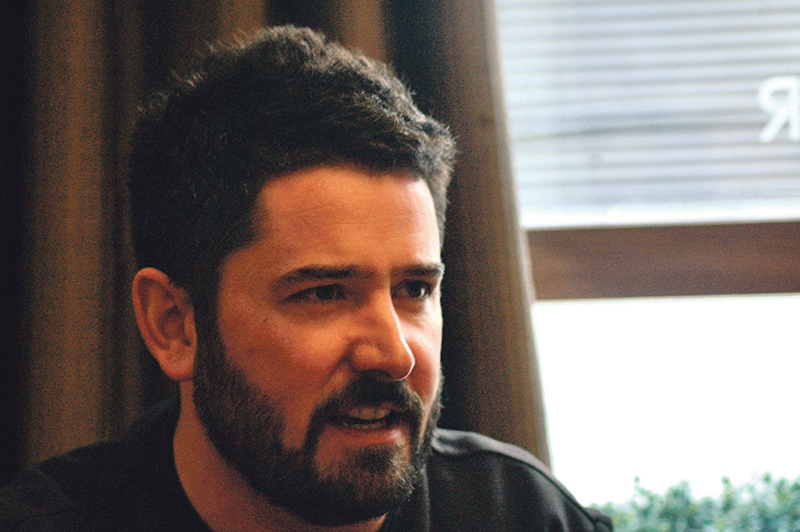Whether laughing and drinking in Oscars pub (after an early screening of his new film Vivarium) or sitting and talking lucidly about it in Brooks Hotel, Lorcan Finnegan is at ease in any company and comfortable discussing a broad range of topics. This aspect of his personality partially explains the hybridity that characterises his films.
His projects, past and future, draw inspiration from sources as diverse as the European cuckoo to fast fashion, and take visual cues from Magritte’s The Empire of Light, to Banksy’s Sweeping It Under The Carpet. The results, Without Name and Vivarium, are hallucinogenic, surreal, Rorschach-shifting (tonally and visually) films that remain grounded in their characters’ psychologies and traumas.
Vivarium, which stars Jesse Eisenberg and Imogen Poots, follows a young couple trying to buy their first home. Their search leads them to an unoccupied housing estate called Yonder, where they become inexplicably trapped and are forced to raise a humanoid baby. The opening act is a transition from the real world to that of Finnegan’s feverish imagination. It was “always part of the plan to tonally shift from Martin [the real-estate agent] being weird funny to that funny scary way that’s almost slightly trippy”, Finnegan says.
“It disarms the audience and helps them to bridge between the real world and the heightened world where everything looks kind of fake and the clouds are fluffy and white and the houses are a sickly, minty green.”
Vivarium disarms the audience and helps them to bridge between the real world and the heightened world where everything looks kind of fake
Finnegan’s films tend to be set in places – be they forests or empty housing estates – which are haunted and haunting in equal measures. His earliest projects, which he produced while studying graphic design, were animated shorts where he’d first “create the world for the story to take place within.” He describes Vivarium as being “like a bigger scale of that kind of stuff. Yonder is a character in a way as well”.
One of the earliest inspirations for Vivarium came from a David Attenborough documentary about the European cuckoo. At the time, Finnegan and screenwriter Garret Shanley were “trying to come up with a new monster for our times”. The idea of having a “brood parasite” as their own monster appealed to them, because such creatures aren’t “motivated by anything other than their own survival”.
The humorous elements of Vivarium partially derive from Finnegan’s background in sketch comedy. He feels that “comedy and horror are two sides of the same thing, they’re Janus-faced”. “The creepy is inexplicable”, he explains. “It’s hard to say why something creates anxiety within you, and it is the same with things that are funny. Laughter is a primal kind of response.” Reflecting on the film as a whole, Finnegan finds it to be quite humorous. “The whole thing is like a sick joke to me, which is also life. Even at the end I find it funny.”
Imogen Poots was the first actor to come on board the project. It was her suggestion that they approach Jesse Eisenberg to star alongside her, an idea that Finnegan loved. He said it was “interesting” working with Poots and Eisenberg “because they both have different styles of acting”. Poots is “much more of a free-spirit style actor” whereas Eisenberg is “a little more technical and likes to prepare in a different way.” Finnegan has no complaints, though, and says they all got along well off-camera as well as on it.
The whole thing is like a sick joke to me, which is also life. Even at the end I find it funny
Finnegan enjoys working within established genres. “Genre,” he argues, “gives you flexibility to work within these ideas and not be tied down to reality”. Vivarium amplifies reality so that “you can see the absurdity of a certain kind of life” – something he says “you wouldn’t be able to do that if it’s a straight drama”.
Finnegan is currently beginning to cast his next film, Nocebo. Nocebo, unlike a placebo, is “more like a curse where somebody tells you that you’re sick and your mind can make your body sick”. He says the film has “a sort of socio-political angle around fast fashion and the exploitation of the East by the West”.
It is widely known that fast fashion fuels many high street stores to enter a race to the bottom to provide the cheapest prices. This encourages companies to prioritise lowering manufacturing costs, which has the effect of making the industry “highly competitive in developing countries so they end up cutting corners in safety”.
This culture has resulted in several tragic accidents taking place in factories, which have claimed hundreds of innocent lives. Finnegan pays particular attention to a fire at a flip-flop factory in Valenzuela in the Philippines, which caused 74 people to lose their lives, and says the incident had a profound impact on this project. Nocebo is “about a fashion designer and a nanny from the Philippines and how their two lives become intertwined in a supernatural thriller”.
Finnegan’s own political concerns may help generate ideas, but they never overwhelm his narratives – they’re “just an undercurrent”, he explains. His films are, first and foremost, pieces of art rather than political statements.
Speaking of politics Finnegan says of the recent general election that “it’s good to see change. We’ve all been ripped off”. Art, however, can be a healthy outlet for anger that can, in turn, stimulate creativity. Finnegan feels that “both Vivarium and Without Name probably owe some of the anger behind them to Fianna Fáil and Fine Gael and what they did”.
Vivarium will be opening the Dublin International Film Festival on Wednesday, February 26th, and will be released nationwide on March 27th.







